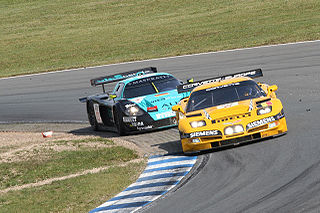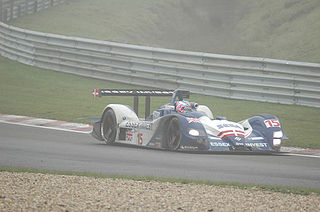
The Lister Storm was a homologated GT racing car manufactured by British low volume automobile manufacturer Lister Cars with production beginning in 1993. The Storm used the largest V12 engine fitted to a production road car since World War II, a 7.0 L Jaguar unit based on the one used in the Jaguar XJR-9 that competed at the 24 Hours of Le Mans. Due to the high price of the vehicle at £220,000, only four examples were produced before production of the road-going Storm ceased. Only three Storms survive today, although the company continues to maintain racing models. The Storm was claimed to be the fastest four-seat grand tourer during the 1990s and early 2000s.

The Aston Martin DBR9 is a racing car built by Aston Martin Racing, debuting in 2005 and racing actively in international sportscar racing until the end of GT1 category in 2011. The name DBR9 is derived from the original 24 Hours of Le Mans-winning DBR1 car, named for then-owner David Brown, which not only won the 24 Hour race in 1959 but also the World Sportscar title. The car is most famous for taking two LMGT1 class wins at Le Mans 24 Hours by the Aston Martin Racing factory team.
Krohn Racing is a professional sports car racing team based in Houston, Texas. The team competes in the IMSA TUDOR United SportsCar Championship Prototype class, and has competed in the FIA World Endurance Championship, Intercontinental Le Mans Cup GTE-Amateur class; the American Le Mans Series GT2 class; and the Rolex Sports Car Series Daytona Prototype class.

The 2006 24 Hours of Le Mans was the 74th Grand Prix of Endurance, and took place over 17–18 June 2006. The winners of the race were Frank Biela, Marco Werner, and Emanuele Pirro, driving the Audi R10 TDI. For the first time in the history of the race, the winner was a diesel-powered car.

The Chevrolet Corvette C5-R is a grand touring racing car built by Pratt Miller and Chevrolet for competition in endurance racing. The car is based on the C5 generation of the Chevrolet Corvette sports car, yet is designed purely for motorsports use. It became one of the most successful cars in GT categories, with wins at the 24 Hours of Daytona, 12 Hours of Sebring, and 24 Hours of Le Mans, as well as championships in the American Le Mans Series. The Corvette C5-Rs debuted in 1999 and continues to be raced to this day in vintage racing events, although the C5-R was effectively replaced by the Corvette C6.R in 2005.

The McLaren F1 GTR is the racing variant of the McLaren F1 sports car first produced in 1995 for grand touring style racing, such as the BPR Global GT Series, FIA GT Championship, JGTC, and British GT Championship. It was powered by the naturally aspirated BMW S70/2 V12 engine. It is most famous for its overall victory at the 1995 24 Hours of Le Mans where it won against faster purpose-built prototypes in very wet conditions. The F1 GTR raced internationally until 2005 when the final race chassis was retired.

The MG-Lola EX257 is a Le Mans Prototype racing car built by Lola for the MG car company for their attempt to compete again at the 24 Hours of Le Mans in 2001. The car has had many years of mixed success since its introduction, even in privateer hands.

The Lola B98/10 was a Le Mans Prototype built by Lola Cars International for use in the International Sports Racing Series, American Le Mans Series, and 24 Hours of Le Mans. It would be the first international sports car built by Lola since they briefly left the sport in 1992 following the Lola T92/10. It would be succeeded in 2000 by the Lola B2K/10.

The Lola B2K/10 was a Le Mans Prototype developed in 2000 by Lola Cars International for use in the 24 Hours of Le Mans, American Le Mans Series, Grand American Road Racing Championship, and Sports Racing World Cup. It was a replacement for the previous Lola B98/10 and shared some elements with its smaller variant, the Lola B2K/40.

The Lola B2K/40 was a Le Mans Prototype developed in 2000 by Lola Cars International as a cheaper, smaller, and lighter alternative to the similar Lola B2K/10. Although specifically designed to compete in the SR2 class of the Sports Racing World Cup and Grand American Road Racing Championship, it would later be adapted to the LMP675 and LMP2 classes for the 24 Hours of Le Mans and American Le Mans Series. This design was replaced in 2005 by the Lola B05/40 and would last be used in competition in 2006.

Jamie Oliver Campbell-Walter is a British professional racing driver. He was born in Oban, Scotland on 16 December 1972. He won the FIA GT Championship in 2000 and took a World Endurance Championship title in 2013 as an Aston Martin Racing factory driver. He now owns and runs Bullet Sports Management with business partner and former team-mate Nicolas Minassian.

The Chrysler Viper GTS-R was a successful racing variant of the Dodge Viper developed in conjunction with Chrysler of North America, Oreca of France and Reynard Motorsport of the United Kingdom. Officially unveiled at the 1995 Pebble Beach Concours, it has won numerous championships and famous events in its history.

The Reynard 02S was a Le Mans Prototype race car built by Reynard Motorsport in 2002. Intended to replace the failed Reynard 2KQ prototype, the 02S would end up becoming the final new design from Reynard as the company went bankrupt prior to the project's completion.

The Riley & Scott Mark III was a sports prototype auto racing car developed by Bob Riley, Bill Riley and Mark Scott of Riley & Scott Cars Inc. Initially designed in 1993, the car was created for the World Sports Car (WSC) category which was to debut in the North American IMSA GT Championship during their 1994 season. It was not until 1995 that the first Mk III was completed, but the construction of further cars allowed a variety of teams to campaign in several North American and European racing series, including competing at the 24 Hours of Le Mans.
Multimatic Motorsports is the competition arm of Multimatic Special Vehicle Operations. Founded in 1992, the team has competed in the Firestone Firehawk Series, Motorola Cup, IMSA GT Championship, American Le Mans Series, Grand-Am Cup, Rolex Sports Car Series, Michelin Pilot Challenge, FIA World Endurance Championship and the 24 Hours of Le Mans. Multimatic Motorsports is celebrating its 30th anniversary in 2022.

Extreme Speed Motorsports (ESM) was an American auto racing team based out of Riviera Beach, Florida. Founded by Scott Sharp and Patrón CEO Ed Brown, the team competed in the FIA World Endurance Championship, Tudor United SportsCar Championship, and American Le Mans Series since 2010 until 2018 when the team sold its equipment and race cars and shut down following an exhaustive sponsor search after the withdrawal of Patrón.
Elton Julian is an American racecar driver and team owner. After driving at the International Formula 3000 and the FIA World Endurance Championship, he has entered DragonSpeed at the FIA WEC, WeatherTech SportsCar Championship, European Le Mans Series and IndyCar Series.

Nicholas Leventis is a retired British racing driver and founder of Strakka Racing. One of his most memorable successes was winning the 2010 24 Hours of Le Mans in the LMP2 category with Danny Watts and Jonny Kane, breaking five records in the process.

Meyer Shank Racing is an American motorsport organization that competes in the IndyCar Series and the IMSA SportsCar Championship.
Intersport Racing is a former American auto racing team founded by Jon Field. The team was based in Dublin, Ohio. They previously operated two Oreca FLM09 sports cars in the American Le Mans Series. At current, the company has transitioned into diet supplements.


















